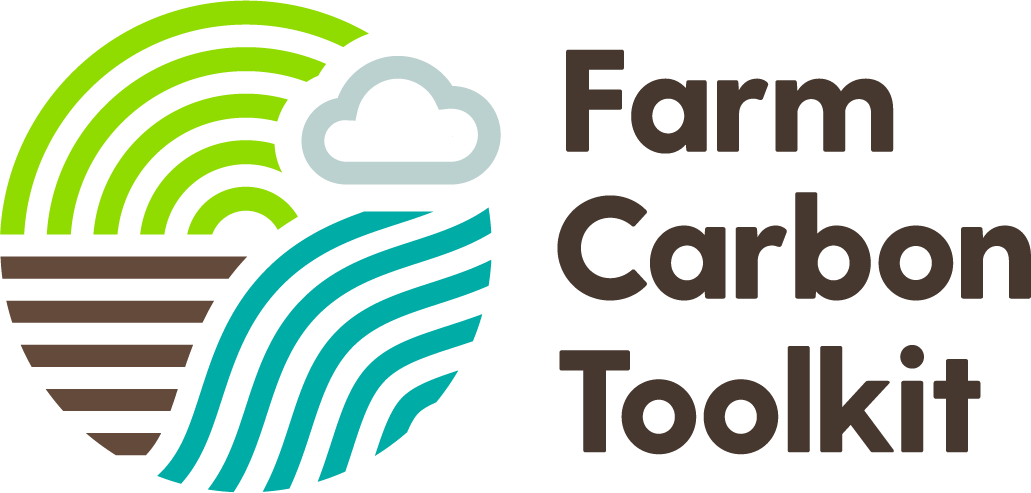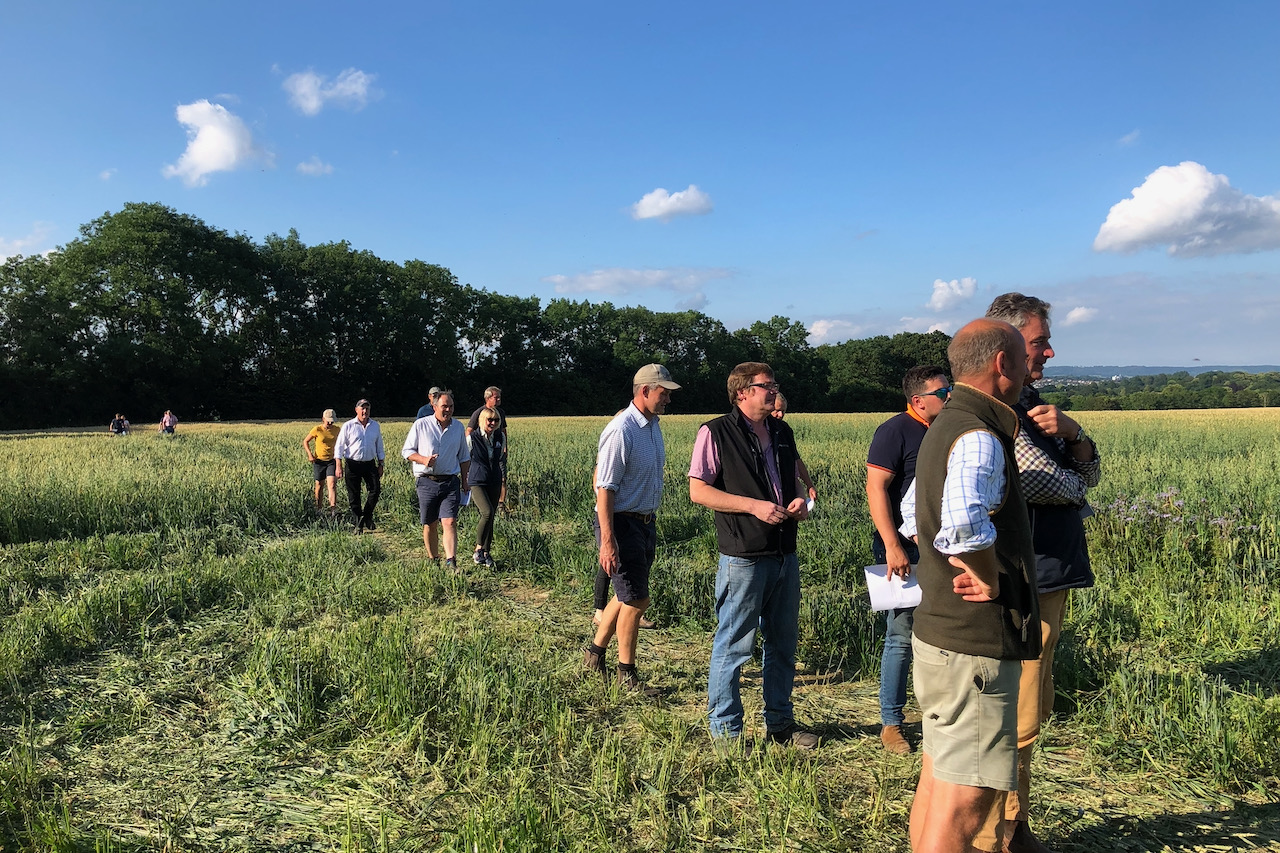
On a sunny evening, a group of farmers met in Kent to hear why Tom Sewell had been awarded arable Soil Farmer of the Year for 2021 and to dig a little deeper into his farm and soil management.
Tom is a second-generation farmer, working in partnership with his wife Sarah and his parents. They are both Nuffield scholars and have also completed the Worshipful Company of Farmers management course, both of which he credits with helping him continue to innovate and develop the farm system. Tom is an early adopter of direct drilling in the UK, being a founder member of BASE UK and being a regular columnist in Direct Driller magazine, so it was a great opportunity to come and hear more about how the system works.
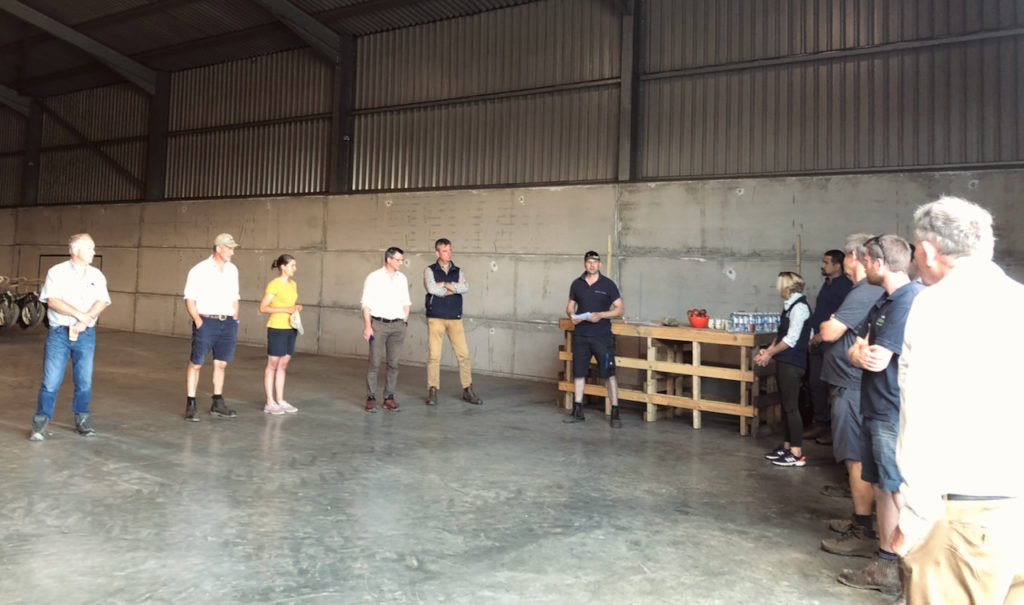
They are currently farming about 1500 acres with 15 different landowners, across 8 different parishes in Kent, and so logistics can be a little challenging! Tom explained to the farmers present that he is often known for the ‘things that they don’t do’ which include applying any bagged P and K or working on Sundays.
The soils across the farm are variable, the farm starts in the Medway valley – and comes up from there. Across the farm there are some areas of Grade 1 river silt which is lovely but floods, as you come up the valley the soil changes into heavier soils which are rocky; these have good structure but are hard on machinery. Tom explains “We maintain the good structure by not ploughing and using our worms.”
Tom constantly evaluates the business in terms of operational efficiency and costs, and challenged the farmers present to do the same,
“Look at what you do and why you do it and see if you can cut it out.”
The system that Tom runs is fairly low cost and simple, although the farm was one of the early adopters of a cross slot drill (which isn’t low cost!), and he is operating across multiple land owners, the underlying principle is as little (preferably no) tillage as possible. Almost everything across the farm is direct drilled, cover crops are used where possible and compost is applied to help build soil health and carbon. All straw is chopped, nothing is baled (even when the price is high). One of the main motivators for the transition to direct drilling was the high stone content of the soil, Tom comments “Why would we want to bring the rocks up? We want them to go down and with this system they are a lot less of an issue. They are really abrasive and heavy on machinery; when we used to plough we were changing a set of points at lunchtime.”
Tom has been at the forefront of the transition to no till for many years. He started with a disc press, then a Simba Free flow drill when he realised that moving to no till could work for the soil and system. During his Nuffield travels he focussed on long term no till and visited farmers in Paraguay who had been running a similar system for over 30 years. On his return he purchased his cross slot, and was the second one in operation in the UK. After the introduction to the farm at the grain store, the group loaded onto the trailer and went off to see some crops.
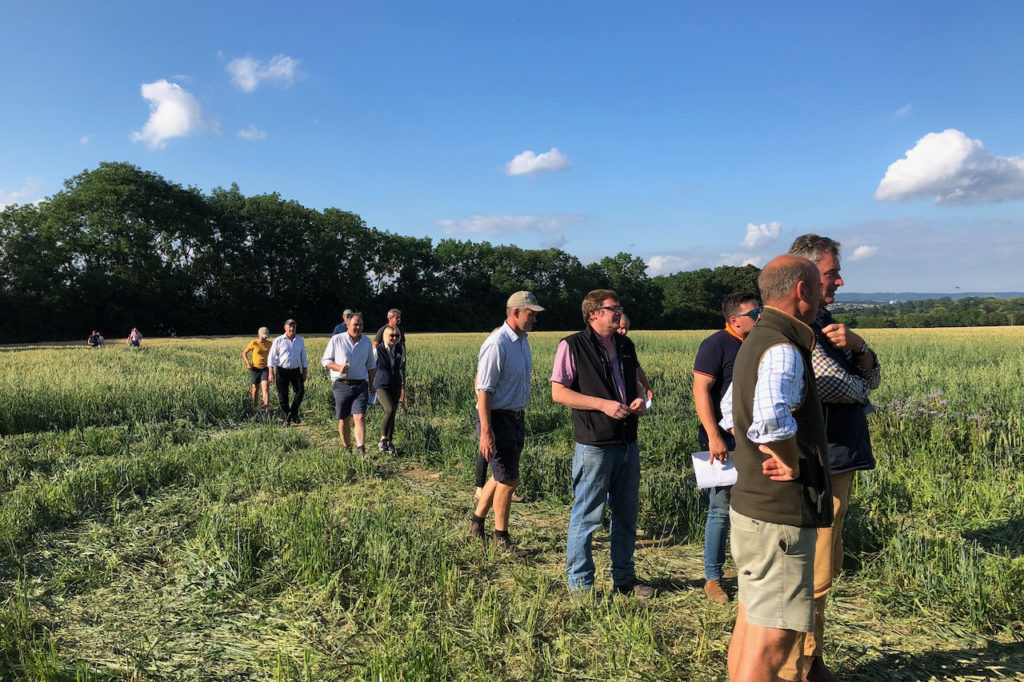
The first stop was to a field which the farm has only recently taken on last year after it had been farmed using a fairly intensive cultivation system with all residues removed. Tom has direct drilled it with a second wheat, and is taking the time to ‘get some life back into it’ although he admits the process will take 5 years. He will apply compost to the field, chop the straw and aim to get the soil health to improve. When the field was taken on, the field just had a basic soil test, but Tom does test using a more biological analysis routinely across the farm.
The group stopped in front of a big pile of compost which Tom uses to help awaken the soil life. He explains,
“I just want to improve the soil, I use compost and feed the worms, they’ll do the rest.”
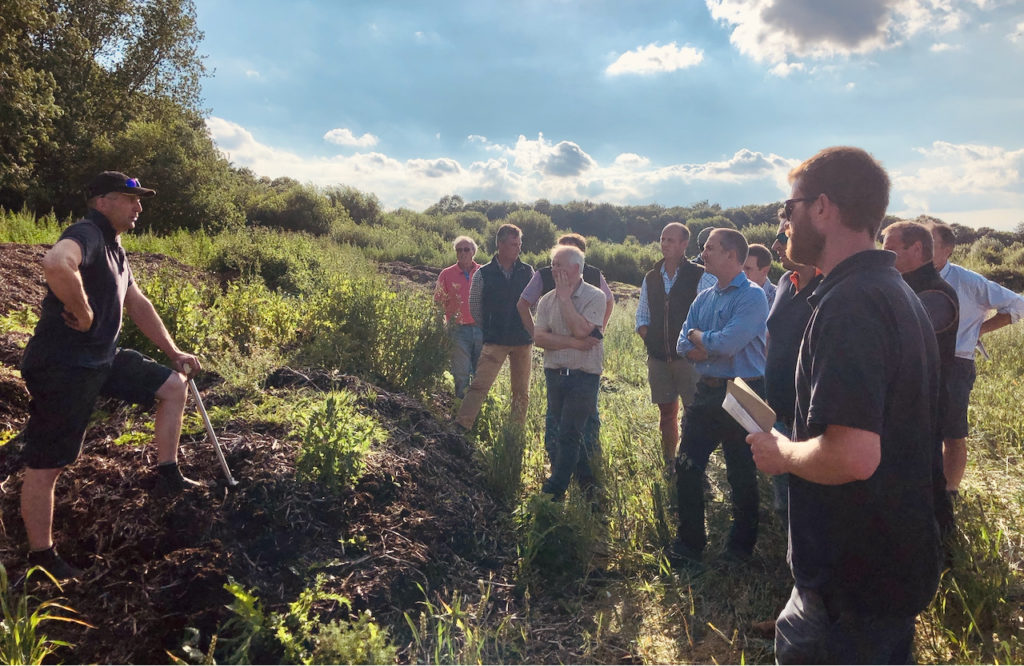
Worms are in abundance on this farm, Tom has done some testing in the past and cites 12 million worms per ha. The compost is made from a lot of horticultural by products which are in abundance in Kent, this heap is made from spent raspberry and strawberry plants and are freely available and a key attribute for turning the soils around. The compost is applied where it needs to go, there isn’t a set application rate, flexibility is important as well as the logistical challenges! The compost pile here will be applied to this field to get the roots and the worms working,
The discussions moved onto cover crops and their use across the farm. They have been included as part of the rotations for about the last 8 years. Cover crop selection depends on budget, what he is trying to achieve and length of time before the next crop, it’s not imperative that everything is cover crops, if there is only going to be a short gap, it’s not the end of the world if it is left. However if he has taken off winter barley or rape then there is space.
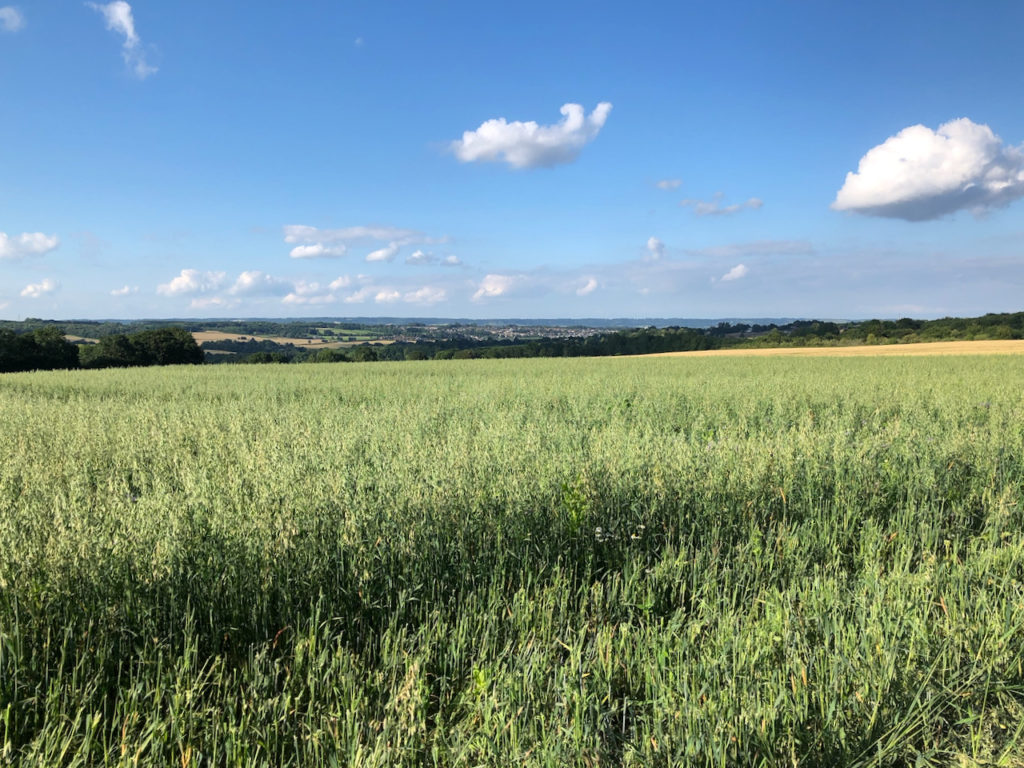
This field had a cover crop planted which was a mix of species and planted March / April time just to get some life back in the soil because it was pretty bare. “The cover crop help to provide that living root,” Tom explains, “and to get organic matter and carbon back into the soil and help the soil to perform. This field was full of rocks from the previous cultivation, we’ve probably picked up 20 tonnes of rock over the winter which we will continue to do, but if we can get the worms to help then so much the better.”
The next stop on the trailer was to look at some wheat from some land that had previously been down to orchards. The range of fields that were visible had been taken on by Tom over the last few years to try and help even things up. The wheat field was Extase, which was looking pretty good on the top but Tom admitted that the conditions had been less than ideal when it went in. There were discussions about the benefits of using the Cross slot or the Horsch drill and whether you could tell which field had been drilled with which! “The fields can be in a bit of a state after the orchards have been taken out,” Tom explains, “the trees are ripped out and tracked all over with a digger, we’ve literally just run over with a set of discs lightly to level it and then put a crop in with the Horsch drill. Most of the winter I was thinking it wasn’t going to make it but the crop came through, but it shows what we have to deal with. We will probably low disturbance sub soil it for the remaining roots this year, pick up a load more rocks and it will go into winter beans.” This was an example of some of the variation that is found across Tom’s farm and the flexibility of management that is required to get the fields into a condition where crops will thrive.
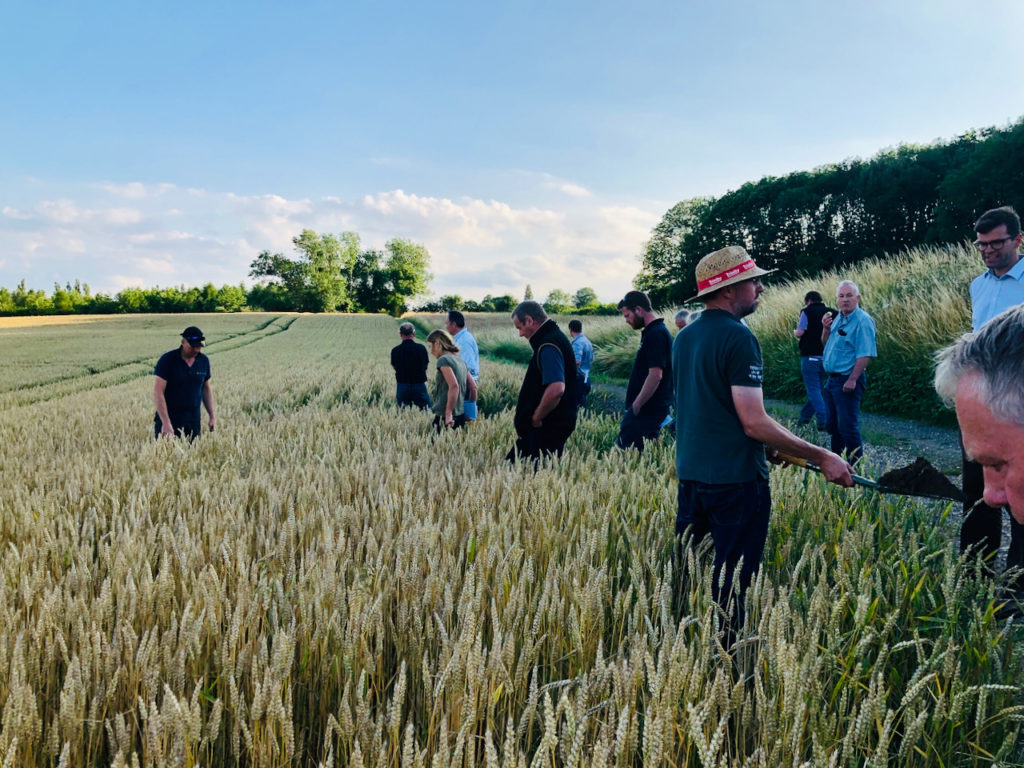
The trailer then took us down through some fields of lavender and up to some fields of wheat that have been under Tom’s management system for much longer. The wheat field looked absolutely fantastic and one thing that Tom was commenting on was how smooth the tramlines were, which he is seeing more and more as his system develops. “We have been through this field 10 times with the sprayer as we use it to apply liquid fertiliser as well, so some areas will have had 20 passes, but if you go and have a look at those areas – they look great. This just shows how well structured the soil is, we would have been out in February putting on liquid fert but you can’t even see a mark.”
The field has previously been a pear orchard about 7/8 years ago. The field was drilled with the cross slot on 9 inch rows. The soil looked brilliant, well structured with plenty of worm activity and aggregation. Questions were asked about the time it takes to get it to this condition, and the ability to transition land which is rented.
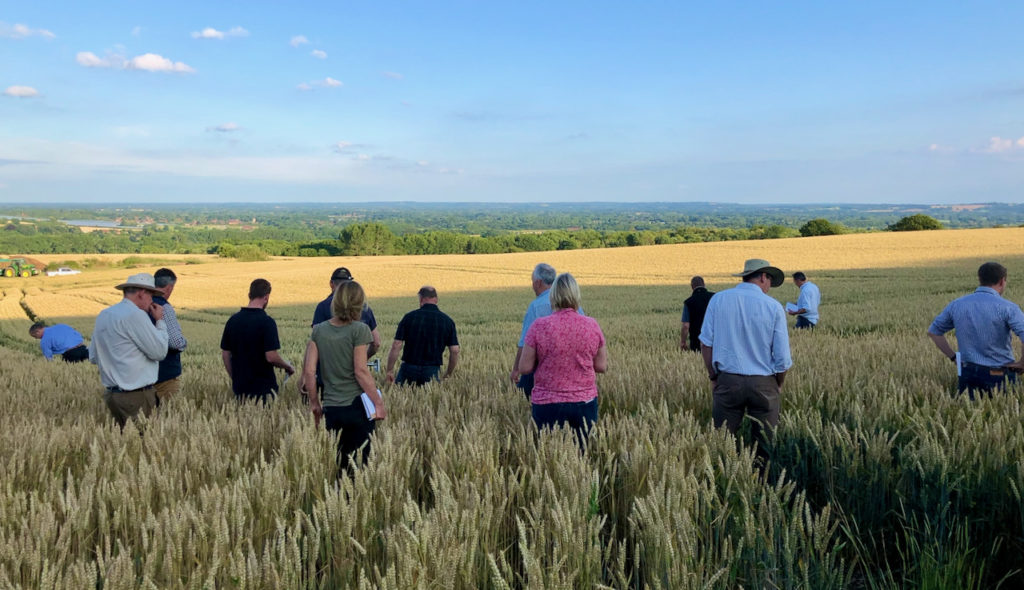
“We look after the land like its our own,” Tom explains, “if you can farm it regeneratively then we cover our costs and three years is long enough. We’re confident that if we can look after it right then we’ll maintain that area, its also about relationship building with land owners, we explain our system and our philosophy and that seems to work. We’ll get it right, but it takes time, effort and attention to detail.”
Discussions moved onto Nitrogen and Tom’s current regime, which is a liquid based system. Over the last three years Tom has managed to reduce his Nitrogen by 10% per year which seems to be working well with no adverse impact on crop yield. He is ensuring that a carbon source is applied with his Nitrogen, to ensure that the microbes are fed and the application is balanced and is keen to experiment in the future with biology though brewing. Tom is also making use of beans within the rotation, to allow for a fertility building phase, growing wheat after beans, then a catch crop and then into a second wheat.
The final block that we stopped at was Rock Farm, which has been developed over the last 10 years, the fields had been in permanent derelict orchards, which were then grubbed and brought into the cropping rotation. The field which we stopped at was growing spring oats which will be followed by first wheat. The oats were all drilled using the cross slot into over wintered stubble. The challenging weather this year has been problematic for this block, and after 12 successive frosts in April, the crops were looking stressed, but patience and good soil health have carried them through.
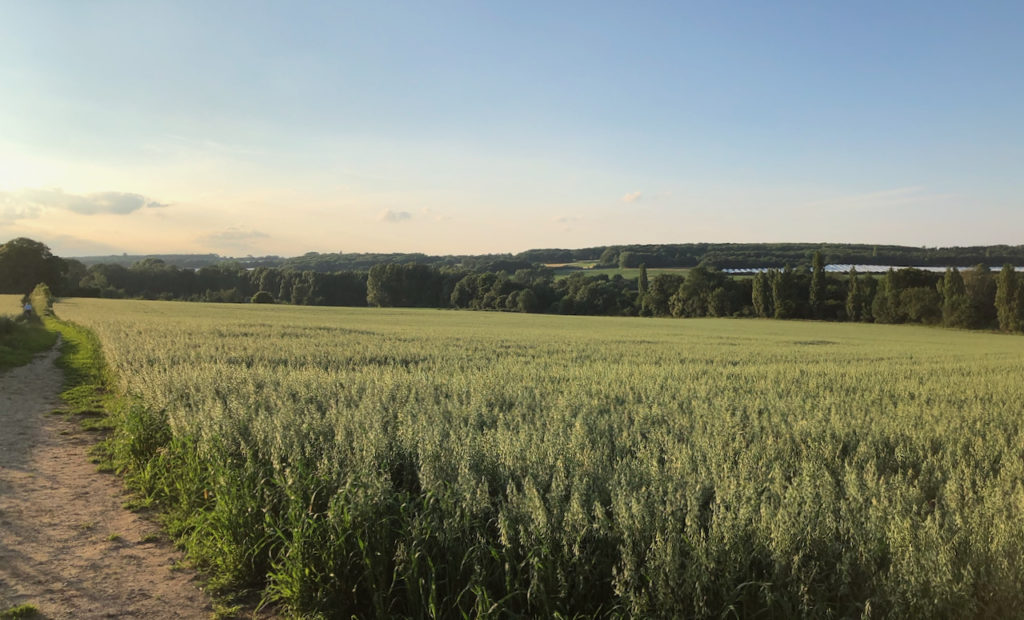
The group then headed back to the farm to more discussions and questions. What was evident from the walk was that Tom’s system, which he cites as being low cost and simple has taken years to perfect, which has required dedication, patience, flexibility and attention to detail. The results were to be seen in the fields where the crops looked fantastic and the soil was alive. Everyone went away with a lot of food for thought!
Thank you to Tom and the team at Sewell Farms for a fascinating evening.
